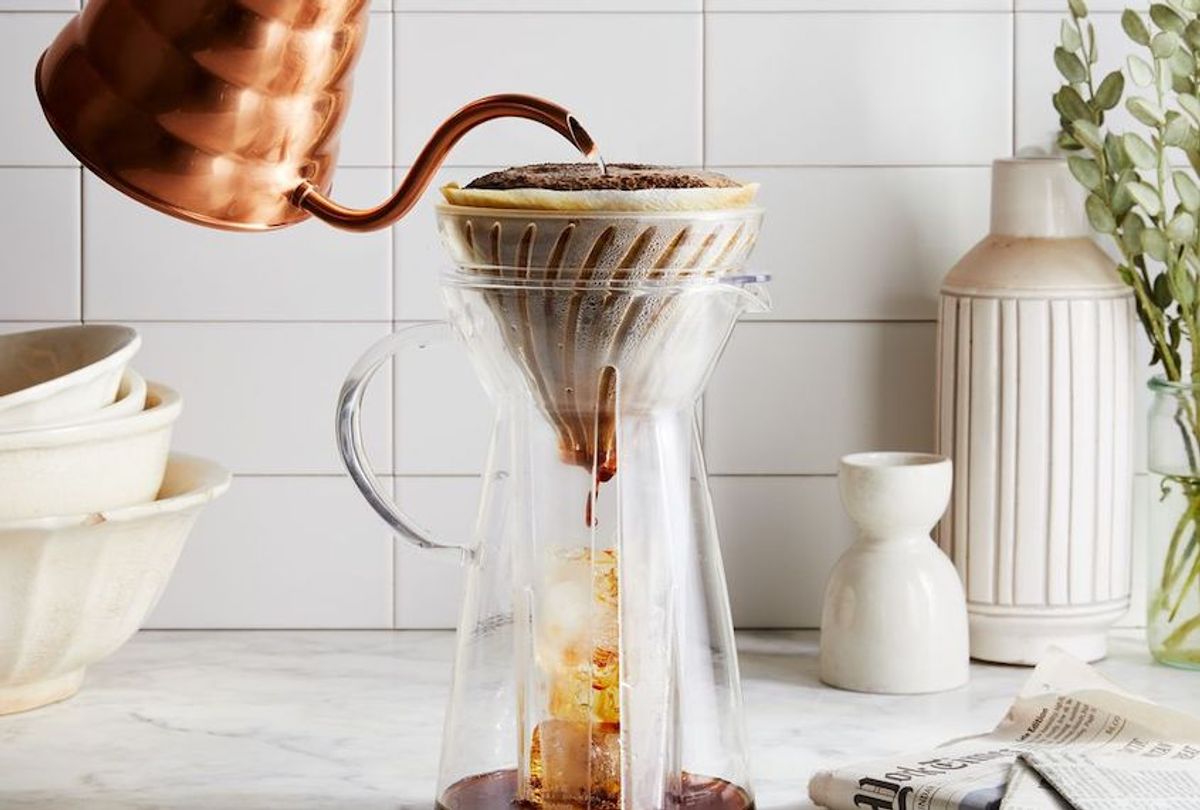When the morning air starts to get warm and a bit sticky, windows cracked open never to shut, and sills fill with fuzzy fruits of varying ripenesses — these are the signs iced coffee season has begun.
For my partner Trevor and I though, iced coffee season is also in the dead of winter. And spring. And fall — and all the mid-seasons between.
Specifically cold brew. A few years ago, we invested in a cold brew drip tower. Every few nights we set up a batch to drip overnight: Cold water filters down through our medium-fine ground Ethiopia Kossa Geshe beans which drips coffee through a squiggly glass apparatus at the rate of one drip per second into a serving carafe. Without the addition of heat, we've found that our morning cup tastes smoother, fruitier (like blueberries!), and less acidic. Also, a shorter cup goes a longer way — the slowed extraction makes for an extra-caffeinated cup (begging to be topped with extra-creamy oat milk).
That being said, there are supposedly others that prefer their iced coffee to have started off hot. As Moka Origins co-founder Jeff Abella explained it to me, "when you brew at room temperature — for enough time to, essentially, replace the extractive powers of heat — the water only extracts the richer flavors and caffeine, leaving behind the acidity. Brewing with 200°F water, on the other hand, pulls more flavors out of coffee — including acidity and bitterness."
But first, a word about beans.
Dialing in a perfectly flavored cup begins even before brewing — in the careful consideration of roast degree. "A light-roasted coffee will taste fruity, tea-like even, as its sugars don't get inordinately caramelized during roast," Abella says. "I like medium-roasted coffee for my cold brew, because its sugars have been taken justfar enough to yield chocolatey, caramelly notes — not burnt — in the cup." Because a hot brew teases out coffee's acidity, Abella's noticed that same medium-roast coffeewill sport lemony notes when brewed hot, then chilled.
As for dark roast? "I've been burned by too many cups of bitter, watery cups of iced dark roast coffee from cafés," Abella laughs. Dark roasted beans are, as you might imagine, aggressively toasted — which might comes across as cozy in a hot cup, but just tastes bitter, acrid on ice. "Any of the nuanced flavors that once existed in the coffee are muddied," Abella says. "That's why cold brew is my preferred method for cold coffee, made from light- to medium-roasts."
Whether you prefer hot coffee that's gone cold, or just cold coffee, know that dilution via ice is the universal enemy. Here are guides to both methods, with tips for preventing a watery cup.
* * *
How to make iced coffee
1. Grind.
Grind your beans for your preferred brewing method (powder-fine for espresso, medium-fine for pourover, medium for drip, coarse for French press).
2. Fill your brewing carafe with ice.
Remember, ice is iced coffee's necessary evil; work with, not against, its dilutive powers. For pourover and drip, fill your brewing carafe halfway with ice; the brewed coffee will be chilled immediately upon drip ("flash-chilling"). To prep an iced Americano or French press, simply fill your serving glasses with ice.
3. Halve the water.
To account for the dilution via ice, reduce your brewing water by half. Doubly concentrated hot coffee plus ice equals correctly concentrated cold coffee. Remember: You can always add more ice cubes, but you can't reintroduce strength.
4. Brew on ice.
Brew the coffee using your chosen method — right over the ice with pourover and drip, or as usual with espresso and French press. Swirl to combine the ice and serve as-is, or with a splash of milk.
* * *
How to make cold brew
1. Coarse-grind your beans.
Given the extended brew time, a coarse grind is fine enough to allow extraction, but not so fine that the cold brew emerges unpleasantly bitter. For cold brew, Abella estimates 1 cup grounds to 7 cups room temperature water. Feel free to play with these ratios, though — and for even finer tweaks, with the grind-size — in finding your ideal strength and flavor.
2. Combine & let sit.
Combine the ground coffee and water in a large sealable jar or French press and stir well. Let sit for anywhere between 12-24 hours before fine-straining or plunging. (Any longer, and you risk an overextracted, bitter brew; any shorter, and it will be weak and flavorless.) Drink straight, on ice, or with a splash of milk.


Shares